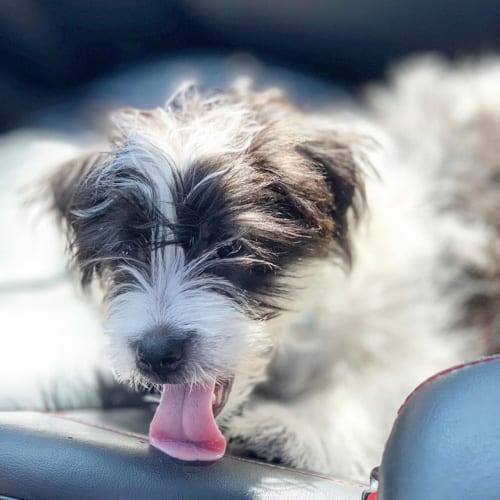Though this may seem like weird behavior, it’s common among many dogs. It’s not clear why dogs lick the air, but it’s thought to be connected to hunting and smelling.
The air your dog licks could contain the scent of another dog or a predator, and your dog is trying to get a closer whiff of the scent.
When your dog licks the air, his tongue is picking up particles that may contain the scent. It’s also thought that your dog likes the taste of the air.
We’ve all seen dogs licking the air, but most of us have questions about why our puppy is doing it. It’s not uncommon to see dogs doing this, especially if they’re bored, anxious, or overly excited.
All dogs lick their lips and the air when they’re about to eat. Also, many dogs lick the air for attention, which is often misread as needing to go outside or as a sign of illness.
Why is my dog licking air? It is a common question for dog owners, but a question with a much longer answer than you might think.
Depending on the context (and the breed and individual dog), licking air is a behavior that can indicate several different things.
We’ve all seen dogs licking the air, but most of us have questions about why our puppy is doing it. In this blog post, we’ll go over some of the most common reasons why dogs lick the air, and we’ll also cover some of the less common ones.

- It’s not uncommon to see dogs doing this, especially if they’re bored, anxious, or overly excited.
- All dogs lick their lips and the air when they’re about to eat.
- Also, many dogs lick the air for attention, which is often misread as needing to go outside or as a sign of illness.
Licking is our dogs’ way of exploring the world, much like humans use their sense of sight to learn about their environment.
(It’s our way of tasting and smelling.) If your dog is licking the air, he may have a problem with his sense of smell, or he may have run into something that tastes or smells interesting.
In the case of the latter, you might see him stop licking and start chewing on something, like a shoe or your favorite pillow.
We’ve all seen it before: our dog suddenly starts licking the air around him or her, like they are trying to catch a fly or something.
The problem is, your dog isn’t licking the air – he’s licking his paws. These are a few of the most common causes of air licking dogs and whether they are out to catch flies.
One of the most common questions that pet owners ask the veterinarians they know is, “why is my dog licking air?” If you’ve ever had this question, you’re not alone.
Related Articles –
- Sheepadoodle – Everything You Should Know About
- Bernedoodle Dog Facts and Information
- Aussiedoodle – 12 Things You Need to Know About
- Pomeranian Husky Mix – 12 Facts You Should Know About Pomsky
In addition to licking air, sufferers of the air-licking syndrome (ALS) exhibit several other odd behaviors. These include air-bathing, air-sniffing, air-pawing, air-pushing, and air-biting.
These behaviors are at the heart of the Air Licking Society, which is calling for increased government funding to research the condition.
What is Air Licking Syndrome or ALS?

Air licking syndrome is a very real thing. It’s classified as a compulsive disorder, and it’s when your dog licks air obsessively.
The reasons for air licking are somewhat unclear, but it is widely believed that it’s an unexpressed form of stress. But what do you do when your dog licks air?
If you can’t stop him from licking air, then you’ll be trying to figure out why my dog is licking the air and how to stop him.
Air-licking syndrome (ALS), also known as air-bathing, is a behavioral problem seen in dogs. When a dog has this condition, he will lick the air and also lick his paws excessively.
This can lead to sores on the dog’s paws, and it can also lead to infections. At the same time, air-licking can also lead to your dog becoming dehydrated. This problem is seen in a wide variety of dog breeds.
If your dog is licking at the air around them or licking things that they can’t see, it could be the sign of an airborne ailment.
Commonly referred to as Air Licking Syndrome or Air Licking Disorder (ALS), this behavior can signify a serious health problem and should be examined by a veterinarian.
What is Air Licking Syndrome? Air Licking Syndrome or ALS is a behavioral syndrome characterized by excessive licking at the air as if the dog is trying to catch invisible objects.
When your dog starts licking the air without anything being in front of them, it’s a sign that something is wrong.
You might be tempted to dismiss this action as your dog being odd, but in fact, he is exhibiting signs of an illness that could be potentially dangerous.
How ALS Occurs?

Dogs can be affected by amyotrophic lateral sclerosis (ALS), also known as Lou Gehrig’s disease. ALS is a neurological disorder that affects a dog’s ability to move.
The disease is progressive, which means that eventually, it will affect the dog’s ability to breathe and swallow. The disease usually starts in the front legs and spreads to the back legs.
The illness affects larger dogs, with herding dog breeds being more prone to the disease than others.
Like humans, dogs can suffer from a variety of diseases. One of the most common diseases that dogs suffer from is a disease of the nervous system.
One of the most common diseases of the nervous system that your dog can develop is amyotrophic lateral sclerosis (ALS), also known as Lou Gehrig’s disease.
ALS attacks the nerve cells that control voluntary muscles, and some breeds of dogs are genetically predisposed to the disease.
When you have a dog, you’ve probably noticed that there is a certain breed that seems to be stricken with a particularly large number of diseases and conditions.
For example, suppose you have a Labrador Retriever. In that case, you know that they tend to suffer from a wide variety of health problems, including but not limited to cancer, hypothyroidism, organ failure, blindness, deafness, and epilepsy.
Dogs of the Labrador breed are also more likely to experience something called ALS, or Amyotrophic Lateral Sclerosis, a degenerative neurological disease that affects the brains of humans and animals.
The disease gets its name because it attacks the motor neurons, or nerve cells, that connect the brain and the spinal cord to the muscles.
Your dog may not be able to tell you that he or she feels something different. Many dogs do not show any outward signs that they are experiencing any signs of pain or discomfort.
Some dogs, however, may lick the air, tremble, walk stiffly, or even lose control of their bladder or bowels. The most common symptom of ALS is a stiff, awkward walk.
This may be due to pain in the muscles that control the legs or because the dog has lost control of its lower spine. In some cases, the dog may stop using one or more of his or her legs altogether or even lose control of bladder and bowel function.
While the dog breeds that experience ALS are rare, it is imperative to get them the help they need once a dog is diagnosed. They need to see their vet immediately.
Keep in mind that there are different kinds of ALS, and the most likely kind for a dog to get is ALS-PLS, which is a form of neuropathy. The dog will most likely live for one to three years with the condition.
What Can You Do for Your Dog with ALS?

The average dog is incredibly resilient, but unfortunately, some illnesses and conditions can severely impact a dog’s quality of life. One example is ALS or muscular atrophy.
This term refers to several diseases that have similar symptoms, which include muscle weakness and atrophy. Most often, this illness occurs in smaller dogs.
The disease is commonly known as Lou Gehrig’s disease, or ALS has an average survival rate of three years, which means it’s important that you start your dog’s treatment plan as soon as you notice symptoms.
The disease’s cause is still unknown, but there are some things you can do to help your dog live as comfortably as possible.
Treating canine amyotrophic lateral sclerosis (or ALS) is a tricky proposition. Usually referred to as “Lou Gehrig’s Disease” in humans, it is a progressive neurodegenerative condition that affects dogs, as well.
However, unlike most humans, dogs don’t have the option to stop eating. Many owners of dogs with ALS choose to stop feeding their pet as a form of euthanasia, but others choose to treat the symptoms or find a cure.
Without treatment, ALS leads to total paralysis of all the muscles in your dog’s body, starting with the limbs and eventually progressing to the muscles required for breathing and swallowing.
The disease progresses quickly—the average time from the onset of symptoms to the point where your dog is no longer able to stand is three to five months. Within a year, your dog shows signs of severe disability and will likely need to be euthanized.
